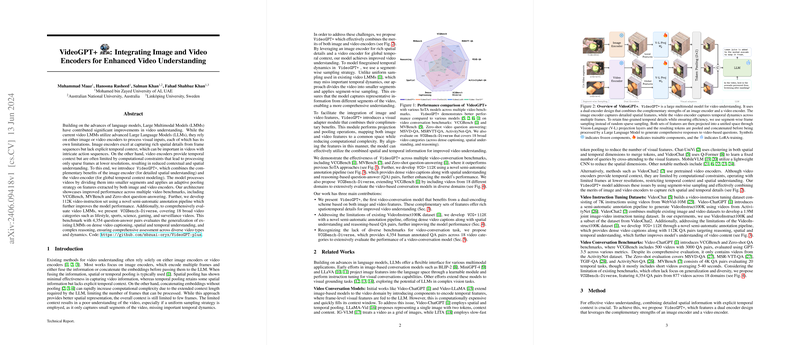VideoGPT+: Integrating Image and Video Encoders for Enhanced Video Understanding
The paper presents VideoGPT+, a model that combines the complementary benefits of image and video encoders for enhanced video understanding. The approach addresses the limitations of current Large Multimodal Models (LMMs) that utilize either image or video encoders. Image encoders capture rich spatial details but lack temporal context, while video encoders provide temporal context but often at the expense of spatial resolution and computational efficiency. VideoGPT+ overcomes these constraints by integrating both encoder types, thereby enabling robust spatiotemporal understanding.
Methodology
VideoGPT+ leverages a dual encoder design incorporating a high-resolution image encoder and a temporal-context-aware video encoder. The key components of VideoGPT+ include:
- Segment-wise Sampling: The model divides videos into smaller segments and applies a segment-wise sampling strategy to ensure comprehensive temporal context capture. This method contrasts with uniform sampling, which can miss significant temporal dynamics.
- Dual Vision Encoder: The architecture employs a CLIP model (ViT-L/14) for detailed spatial information and an InternVideo-v2 for temporal context. This dual strategy ensures a rich representation of both spatial and temporal features.
- Visual Adapter Module: Features extracted from image and video encoders are projected into a common space using visual adapters. This involves projecting image and video features into the language space through specific projection layers, followed by adaptive pooling to manage computational complexity effectively.
- LLM: The integrated features are then inputted into a fine-tuned LLM, which processes the information to generate comprehensive video-based responses. The LLM fine-tuning utilizes LoRA for efficient training.
Results and Evaluation
VideoGPT+ demonstrates strong performance across several benchmarks, indicating its efficacy in video understanding tasks:
- VCGBench: VideoGPT+ achieved an average score of 3.28, outperforming previous state-of-the-art models across all evaluation metrics, including Correctness of Information (CI), Detail Orientation (DO), Contextual Understanding (CU), Temporal Understanding (TU), and Consistency (CO).
- VCGBench-Diverse: Introduced in this work, this benchmark covers 18 broad video categories and extends the evaluation to varying video capturing methods and reasoning complexities. VideoGPT+ achieved an average score of 2.47, showing significant improvements in spatial and temporal understanding.
- MVBench: On the MVBench, VideoGPT+ excelled across a wide range of specific tasks, including action prediction and object interaction, reflecting its advanced temporal understanding capabilities.
- Zero-shot Question-Answering: The model showed superior generalization capabilities on diverse datasets, achieving the highest scores in terms of both accuracy and comprehensive responses.
Dataset and Benchmark Contributions
The paper also introduces VCG+, a comprehensive 112K video-instruction set generated through a semi-automatic annotation pipeline, enhancing model training data quality. Additionally, VCGBench-Diverse offers a diverse and robust benchmark to evaluate video LMMs comprehensively across multiple video categories, capturing different filming techniques and reasoning complexities.
Implications and Future Directions
The integration of both image and video encoders in VideoGPT+ offers significant improvements in video understanding, particularly in capturing fine-grained spatial details and temporal dynamics. The strong numerical results across multiple benchmarks validate the model's efficacy.
The dual encoder design and enhanced annotation techniques pave the way for future research in video understanding, particularly in:
- Action Localization and Prediction: Future models could focus on improving the precision of action boundaries within videos.
- Long Video Navigation: Handling very long videos remains challenging; thus, developing more efficient segment-wise or hierarchical approaches could offer potential solutions.
- Path Following and Reasoning: As video understanding models evolve, enhancing their capability to follow long, complex paths and reason about events within these contexts will be critical for advancing practical applications.
In summary, VideoGPT+ sets a new precedent in video understanding by effectively combining the strengths of image and video encoders. The introduction of a diverse benchmark and an enriched dataset further solidifies its contribution to advancing the field of large multimodal models.
